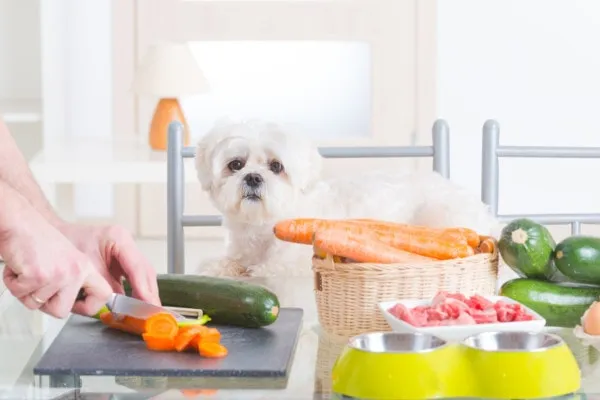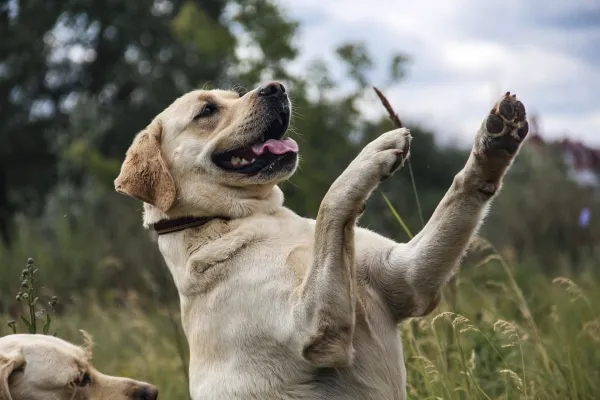As a dedicated pet parent, you’re always looking for ways to boost your furry friend’s health and happiness. While commercial dog food provides essential nutrients, supplementing their diet with fresh, wholesome additions can offer a myriad of benefits. But with so many options, how do you know What Fresh Vegetables Are Good For Dogs and safe to share? Integrative veterinarian Dr. Julie Buzby helps us navigate the world of canine-friendly produce, revealing 14 beneficial vegetables your dog can enjoy and four to always avoid.
Just like humans, dogs can thrive on a diet rich in vegetables. These natural powerhouses are packed with vitamins, minerals, and fiber, making them excellent, low-calorie treats or meal additions for dogs of all ages, from playful puppies to wise seniors. Understanding which veggies are safe and how to prepare them is key to providing your canine companion with a delicious and healthy boost. Before you offer any new foods, it’s always smart to understand what your dog can and cannot eat. You can find out more about general dietary restrictions for dogs, including what foods to avoid, by checking out this comprehensive guide on what dogs can’t eat list.
The Health Benefits of Giving Your Dog Vegetables
Incorporating vegetables into your dog’s diet offers a range of advantages, from supporting a healthy weight to boosting their immune system. These vibrant foods are not only tasty but also highly nutritious.
- Weight Management: For dogs who are overweight, veggie treats are a game-changer. They are naturally low in calories and high in fiber, helping your dog feel full and satisfied without overeating. This can be particularly helpful in managing hunger during a weight loss regimen.
- Digestive Health: The fiber in vegetables is crucial for a healthy digestive tract. It aids in regular bowel movements, supports proper dog anal gland function, and helps prevent constipation, ensuring your dog’s gut stays happy and healthy.
- Immune System Boost: Vegetables are loaded with essential vitamins and antioxidants that play a vital role in strengthening your dog’s immune system, helping them ward off illnesses and stay vibrant.
- Diabetes Management: For dogs living with diabetes, certain vegetables can help stabilize blood sugar levels, making them a beneficial part of their carefully managed diet.
- Antioxidant Power: Many vegetables are natural sources of antioxidants, which combat free radicals in the body and can reduce the risk of various diseases, promoting long-term health.
- Effective Training Rewards: Crunchy vegetables, such as carrots, can make excellent and highly motivating low-calorie treats for training sessions, encouraging good behavior without adding excess calories.
14 Fresh Vegetables Safe for Dogs to Eat
While the desire to share your food with your beloved pet is strong, it’s crucial to know which “human foods” are safe. Many fresh vegetables are fantastic for dogs, offering unique nutritional profiles. Here are 14 top picks recommended for canine consumption.
1. Pumpkin
Despite the ongoing “fruit or vegetable” debate, pumpkin consistently tops the list of dog-safe produce! It’s a superstar for senior dogs or any dog experiencing digestive issues. Rich in fiber, pumpkin can help regulate stool problems – firming up loose stools by absorbing water, or aiding constipation by adding bulk and promoting movement.
Pumpkin also contains linoleic acid, an omega-6 fatty acid found in pepita oil, known for its anti-inflammatory effects, particularly beneficial for a dog’s skin health.
Cooked or canned pumpkin (plain, not pie filling) is the easiest and best way to serve it. Always choose plain canned pumpkin, as pie filling contains added sugars and spices that are not good for dogs. Introduce pumpkin gradually, mixing one to two tablespoons with their regular food. Don’t be surprised if their stool takes on a slight orange tint!
 Small dog patiently waiting at a table, looking forward to a vegetable treat.
Small dog patiently waiting at a table, looking forward to a vegetable treat.
2. Broccoli
Broccoli is another excellent vegetable for dogs. It’s an outstanding source of fiber and also provides vitamin C, vital for a robust immune system. It’s best served cooked and unseasoned, although small pieces of raw broccoli stalks can also be given as a crunchy, low-calorie treat. Always ensure pieces are bite-sized to prevent choking, especially for smaller breeds.
Broccoli should be given in moderation. Excessive amounts can potentially irritate the esophagus and stomach lining, and may also lead to excessive gas.
3. Carrots
Carrots are a popular and healthy choice for dogs, rich in potassium, vitamin B6, and an excellent source of beta-carotene. This compound gives carrots their vibrant orange color and is converted into vitamin A in your dog’s body, which is essential for immune function and healthy vision, preventing issues like night blindness.
Many dog owners serve carrots steamed or boiled. A one-ounce serving contains only ten calories, making them a very filling, low-calorie snack ideal for dogs needing to lose weight. Raw carrots are also a fantastic crunchy treat that dogs adore.
 Owner hand-feeding a fresh carrot to a happy dog as a healthy treat.
Owner hand-feeding a fresh carrot to a happy dog as a healthy treat.
Always supervise your dog and serve appropriately sized pieces to prevent choking. While low in calories, carrots are relatively high in sugar, so they should be avoided for diabetic dogs.
4. Green Beans
Green beans are a nutritional powerhouse, packed with vitamins A, C, and K, as well as minerals like iron and calcium. Their low-calorie, high-fiber content makes them incredibly beneficial, especially for dogs with diabetes or those on a diet. They help dogs feel full without adding many calories.
Serve green beans boiled, steamed, or chopped. Avoid any seasonings and steer clear of canned green beans high in salt. Start with two to three green beans daily, ensuring treats don’t exceed ten percent of their diet unless advised by your veterinarian. You should also be aware of what fruits not to give dogs to ensure their diet is safe and balanced.
5. Kale and Spinach
Dark leafy greens like spinach and kale are superb choices among fresh vegetables for dogs. They are rich in:
- Calcium: Essential for strong, healthy bones.
- Vitamin K: Crucial for proper blood clotting.
- Vitamin A: Supports vision and overall health.
- Iron: A key component of hemoglobin, vital for oxygen transport in red blood cells.
- Folate: Necessary for nutrient absorption in the small intestines.
Kale and spinach can be served steamed or raw, always without seasonings. One or two raw leaves are a great snack, or you can shred them and add them to your dog’s meal.
 A cheerful Beagle dog with a focused expression, anticipating a vegetable snack.
A cheerful Beagle dog with a focused expression, anticipating a vegetable snack.
However, moderation is key with kale due to its high calcium content, which can contribute to urinary problems and bladder stones in some dogs. Consult your veterinarian if your dog has a history of bladder stones or other metabolic concerns.
6. Brussels Sprouts
These mini cabbages are another high-fiber vegetable offering vitamins C and K, along with trace minerals like magnesium, which supports cellular metabolism and muscle function. When preparing Brussels sprouts, avoid oils or seasonings. Start with one or two at a time, as too many can cause gas, bloating, and abdominal discomfort.
Serve Brussels sprouts steamed or boiled, and always cut them into smaller pieces. Whole, round Brussels sprouts can be a choking hazard for small and medium-sized dogs.
7. Zucchini
Zucchini is a fantastic source of calcium, iron, magnesium, and fiber, all promoting a healthy gastrointestinal tract. It can be served raw or steamed; steaming makes it softer and easier to chew if your dog prefers a less crunchy texture.
Begin by offering three to four slices at a time and ensure there are no seasonings or salad dressings. Many dressings contain toxic ingredients for dogs, such as garlic and onions. Additionally, some dressings may contain xylitol (birch sugar), which is extremely toxic and can lead to xylitol toxicity in dogs, causing hypoglycemia, seizures, liver failure, and even death.
8. Sweet Potatoes
Sweet potatoes are a flavorful, high-fiber food often found in commercial dog foods. They are excellent sources of vitamins A, B6, and C, making them a very tasty and nutritious treat.
There are various ways to serve sweet potatoes. If raw, chop them into small cubes. Steaming or roasting makes them softer, more palatable, and reduces choking risk. Introduce them with three or four slices at a time.
Similar to carrots, sweet potatoes are high in sugar, so they should be given sparingly or avoided for overweight and diabetic dogs.
9. Peas
Snow peas and sugar peas are wonderful for dogs, providing good sources of vitamins A and B, and minerals like potassium, magnesium, and zinc. Zinc supports a healthy immune system and thyroid function.
Steam or boil peas before feeding them to your dog. A one-ounce serving contains only twenty calories, making them an ideal low-calorie snack.
 A vibrant assortment of safe vegetables for dogs, including carrots and peas, displayed on a wooden table.
A vibrant assortment of safe vegetables for dogs, including carrots and peas, displayed on a wooden table.
Avoid canned peas due to their high salt content. Peas also contain purines, a type of protein, so dogs with urinary incontinence in older dogs or kidney issues should generally avoid them.
10. Corn
Often viewed as a “filler,” corn actually offers significant nutritional benefits for dogs, and is a common ingredient in many dog foods. Its advantages include:
- Digestible Carbohydrates: Provides an excellent energy source.
- Linoleic Acid: An essential nutrient not produced by dogs, vital for healthy skin, coat, and immune system.
- Rich in Fiber: Supports digestive health and motility.
While corn kernels are safe, corn on the cob is not. The cob is indigestible and can cause blockages in the stomach or intestines, potentially requiring emergency surgery. If you feed corn, ensure it’s steamed kernels, free of extra seasoning, high salt, or butter.
11. Celery
Like many other beneficial vegetables, celery is low in calories, fat, and cholesterol, making it another great veggie treat for dogs on a diet. Celery should be thoroughly washed and fed raw. Dogs who enjoy a good crunch often become celery fans. However, it’s not as flavorful as some other vegetables, so don’t be surprised if your dog isn’t keen on it.
12. Cooked White Potatoes
Cooked white potatoes are a safe and nutritious vegetable for dogs, providing excellent sources of vitamin C, vitamin B6, iron, and magnesium, all crucial for your dog’s immune and nervous systems. The key word here is “cooked.”
Raw potatoes are toxic for dogs. As members of the nightshade family, they contain solanine. Cooking removes this substance; otherwise, solanine can cause stomach upset, vomiting, and bloating.
13. Cauliflower
Cauliflower is a super-vegetable packed with a wide array of healthy nutrients, including:
- Fiber
- Vitamin K
- Antioxidants
- Vitamin A
- Vitamin C
- Beta-carotene
- Minerals like potassium, calcium, and magnesium
Cauliflower can be fed cooked or raw, cut into bite-sized florets. While a great addition, it’s important not to feed too much. Its fibrous nature can pose a choking hazard or cause an upset stomach if consumed in excess.
14. Beets
Beets are one of the most antioxidant-rich vegetables. With an 88% water content, they also contain folate, fiber, vitamin C, and essential minerals, making them highly beneficial for your dog’s skin and coat health.
Don’t be alarmed if you notice small amounts of red or pink coloring in your dog’s urine after they eat beets; this is due to a natural pigment. If the discoloration persists 48 hours after stopping beets, consult your veterinarian.
 Small white dog observing its owner preparing a meal with fresh vegetables and carrots.
Small white dog observing its owner preparing a meal with fresh vegetables and carrots.
What Vegetables Should Dogs Never Eat?
While many fresh vegetables are good for dogs, some are distinctly harmful and should never be offered to your canine companion. Awareness of these toxic foods is just as important as knowing the safe ones. If you’re looking for an even broader understanding of potentially harmful ingredients, including meats, you can read more about what meat should all dogs avoid and what is the one meat dogs should never eat.
1. Onions, Garlic, Chives, and Shallots
Vegetables belonging to the Allium family—including onions, garlic, chives, and shallots—are highly toxic to dogs. They can damage red blood cells, leading to anemia. If your dog consumes any of these, contact your veterinarian immediately, as emergency treatment may be necessary. Symptoms can take days to appear, so prompt action is crucial.
2. Mushrooms
While some mushrooms might be safer than others, it’s generally best to avoid giving any mushrooms to your dog. Some varieties can cause gastrointestinal upset, leading to diarrhea, stomach pain, and nausea. Other mushrooms, particularly wild ones, are far more dangerous and can cause severe, life-threatening illnesses such as liver failure, kidney disease, lethargy, seizures, and even death. Given the difficulty in identifying safe versus toxic species, it’s safest to avoid all mushrooms.
3. Unripe Tomatoes
Like potatoes, tomatoes are part of the nightshade family. The toxic compounds in tomatoes (solanine) are most concentrated in unripe, green tomatoes and the tomato plant itself (leaves and stems). Therefore, your dog should never consume green, unripe tomatoes or any part of the tomato plant.
If your dog ingests a tomato plant, consult your veterinarian immediately. Clinical signs of toxicity can include gastrointestinal upset (vomiting, diarrhea), dilated pupils, depression, decreased energy, and an increased heart rate.
4. Any Vegetables That Pose a Choking Hazard
Throughout this article, the importance of cutting vegetables into bite-sized pieces and properly cooking them has been emphasized to prevent choking. This is critical because choking can quickly become a serious emergency. Fibrous vegetables that are hard to chew, such as large pieces of raw cauliflower or celery, require extra caution. Always supervise your dog closely when introducing new or crunchy vegetables.
How to Prepare Vegetables for Your Dog
When it comes to preparing vegetables for your dog, you have several options: raw, steamed, or boiled. The best method often depends on the type of vegetable, how your dog prefers to eat it, and any specific dietary needs. If your dog seems uninterested in vegetables, try switching up the preparation method—some dogs, like humans, have preferences! My own dog and I might not enjoy raw broccoli, but we both love it steamed.
Here are some general tips for preparing vegetables as snacks for your dog. Always remember that some vegetables have specific “best practices” as mentioned above.
Raw
Raw vegetables make excellent, convenient treats. They are easy to grab and take with you on walks or outings. Baby carrots are a favorite for many dogs.
When feeding raw veggies, proper cleaning is paramount. Unlike cooked vegetables, raw ones are not exposed to high temperatures that kill bacteria and microbes. Thorough scrubbing and washing are essential to remove dirt, pesticides, and potential bacteria before offering them to your dog.
Steamed
Steaming is a fantastic way to prepare vegetables for your dog. It’s quick, easy, and helps preserve the nutrients.
Here are a few tips for steaming:
- Wash vegetables thoroughly before steaming.
- Chop them into uniform, bite-sized pieces to ensure consistent cooking.
- Once steamed, allow the vegetables to cool completely to prevent your dog from burning their mouth.
Steamed vegetables are cooked just enough to soften them slightly while retaining a pleasant, crisp texture that many dogs enjoy.
Boiled
If your dog has missing teeth, a sensitive mouth, or prefers a very soft texture, boiled vegetables might be the best option. Boiled vegetables are softer than raw or steamed ones, making them easier to chew and digest. Keep in mind that boiling can reduce some nutrient density due to water immersion and higher temperatures. All the tips for steaming vegetables (washing, chopping, cooling) also apply to boiling.
 Energetic yellow Labrador standing on its hind legs, eagerly waiting for a healthy vegetable reward.
Energetic yellow Labrador standing on its hind legs, eagerly waiting for a healthy vegetable reward.
Are There Other Ways to Prepare Vegetables for Dogs to Eat?
If your dog isn’t a fan of typical veggie preparations, you can get creative! Here are a couple of tricks to try:
- Pureed: Use a blender to mash thoroughly washed vegetables into an applesauce-like consistency. Many dogs prefer this texture, and pureed vegetables can be easily mixed into their regular dog food.
- Frozen: Frozen vegetables are a great summer treat! Most fresh vegetables should be washed thoroughly and then cooked (steamed or boiled) before freezing to ensure safety and palatability.
Chews Wisely with Your List of Vegetables Dogs Can Eat
Even if your dog enjoys a high-quality commercial diet, incorporating fresh vegetables offers numerous health advantages, making them a beneficial and tasty supplemental treat. Remember, these vegetables are not meant to provide a fully balanced diet on their own; they should be given as supplements and not as a dog’s sole food source.
Experiment with a variety of safe vegetables to discover which ones your dog loves the most. When introducing any new dog-safe vegetable, always offer a very limited amount at first to observe for any adverse reactions. If you have any concerns about whether a particular vegetable is safe for your dog’s specific health history or background, always consult your veterinarian for personalized advice and guidance.
Does Your Dog Love Veggies? Which Ones?
Share your experiences and quick preparation tips in the comments below – we’d love to hear from you!
